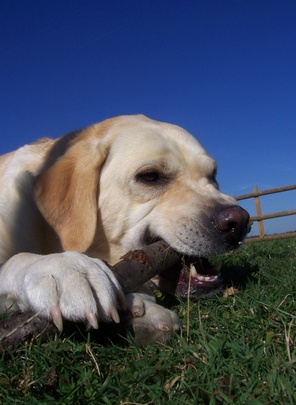About You, Your Labrador Retriever And Your Home
Bringing your Labrador Retriever puppy home for the first time is a wonderful and memorable moment for you, your family and your Lab.
Ideally your Lab should be between seven and nine weeks old when you bring him home and it is important that you spend as much time as possible with him.
A Lab aged between seven and ten weeks is at the absolute optimum for learning new things.
His experiences during this time will shape his behaviour and prejudices for ever more.
Short training sessions will benefit your lab immensely and he will earn loads.
Similarly, any bad experiences could put the collywobbles up him for ever so don’t expose your puppy to anytime that could be potentially frightening to the little feller.
His New Environment
Chances are you have never looked at your home through a puppies eyes.
Try it.
Suddenly that antique vase resting on the slender table in the corner might not be such a good idea; those exposed wires from the TV running along the skirting board may not quite so out of the way after all; a toddlers toys in a basket will be like a red rag to a bull.
In short, before you bring your Labrador Retriever home you need to ‘puppy proof’ your house!
Puppy proofing a house is pretty much the same as childproofing except that toddlers don’t chew as much as a Lab puppy!
As prevention is better than cure remove all temptations from your puppies reach; trying to teach not to jump on your expensive rug is hopeless at that age; much better to simply remove the item in the first place until he has been taught and can be trusted to be left.

How To Puppy Proof Your Home
Labrador Retriever puppies will chew anything. And I mean anything. He is also the most fearless and clumsy creature imaginable. If he sees something he wants he will go and get it. No matter what obstacles are in the way.
The golden rule about puppy proofing is to make sure all breakables, especially valuables, are well out of reach and preferably out of sight.
Never, ever leave small objects around for your puppy to investigate. You may not eat a packet of cigarettes or tube of ointment but your puppy will!
Don’t leave him the temptation.
Ensuring all electrical wiring is encased in a plastic sheath will help protect both the wiring and the puppy from being frazzled and, above all, don’t leave the little feller unsupervised.
If you do don’t be surprised to find your furniture chewed to bits when you return.
One of the first things you need to teach your Lab Retriever is what he is able to chew.
Give him good quality toys and chew bones and, if he does get hold of something he shouldn’t (and I include slippers here – trust me you don’t want your Lab to get into the habit of chewing your slippers) gently take it from him and substitute the item with one of his toys or bones.
He will soon get the idea.
Related Articles
Life Outdoors For A Lab Retriever
Garden Dangers For Labs
Grooming, Bathing And Nail Clipping Your Lab
The British Lab Retriever
Yellow Lab Retrievers
The Silver Labrador
AKC Lab Retrievers
The Labs Temperament
Dogs Crates And Lab Retrievers
From Labrador retriever To The Labrador Retriever Guide Home Page